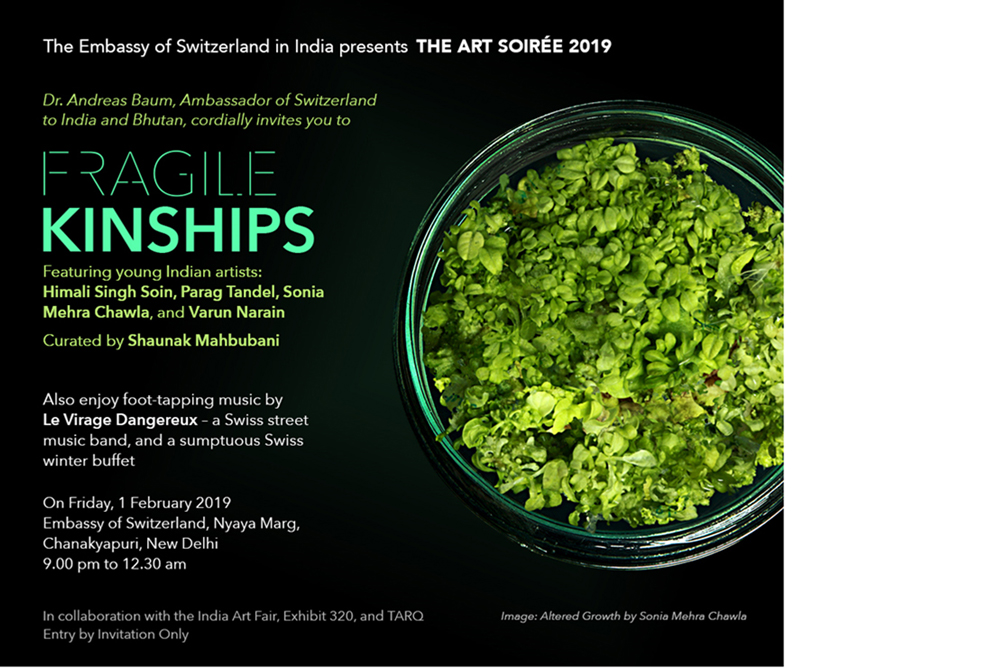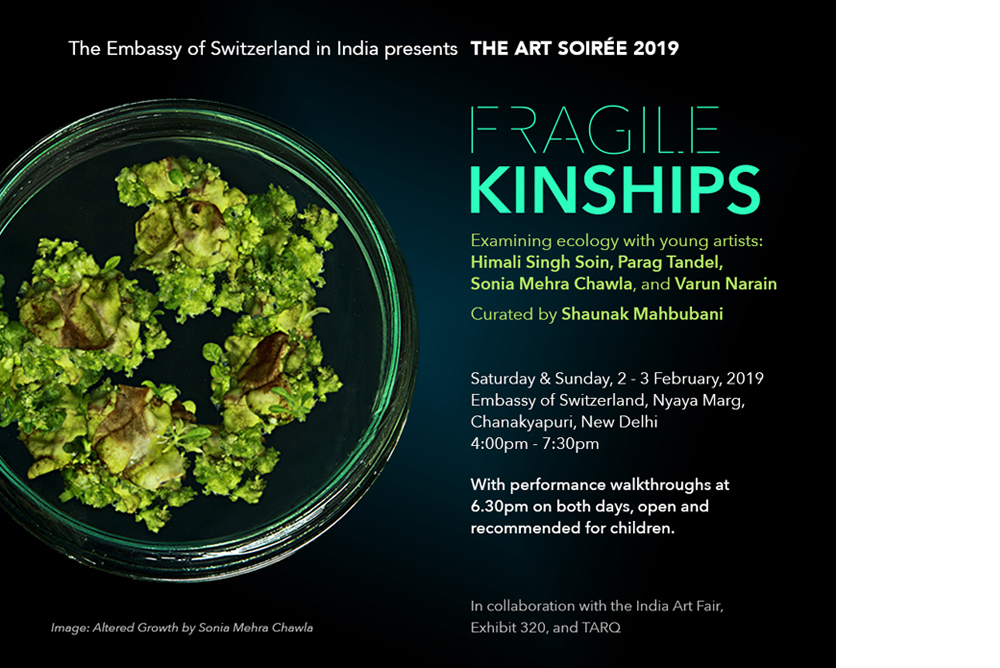

|
FRAGILE KINSHIPS THE ART SOIREE 2019 EMBASSY OF SWITZERLAND IN INDIA In collaboration with India Art Fair 2019. |
|
 | |
 | |
| Curator's Note Anthropocene, one of the buzzwords of the 21st century, has rapidly gained currency in the past few years, moving dangerously close to the realm of over use. The idea popularized in 2000 by Paul Crutzen and Eugene Stoermer, is proposed as the successor to the Holocene which began 11,700 years ago, after the last ice age. While debates on the validity of the new terminology go on, one of the useful facets of the term (possibly one of the only few currently) lies in its structural formulation, acting a pointer to consider the grand centrality of humans- anthropos in all our perceptions of the world. Thinking forward from this postulation, and thinking through the ecological and geopolitical crises we find ourselves in, what effects does the centrality of the self have on the integrity of our kinships? New ways of living require new ways of seeing, of knowing and of being with one another. Donna Haraway throws open multispecies companion thinking in her wet, porous, muddy and mundane imagination of the Chthulucene- Greek chthonios, meaning "of, in, or under the Earth and the seas." Through her writings over many years, she urges us not to think of, but to think with the diverse range of critters we share the Earth and the seas with.This kind of thinking is also embodied in The Last Jungle of Earth, a post war story by Randhir Khare. Through his motley group of species, ranging from elephants, to an owl, a jackal and a mind reading dodo, journeying together to review the Mother Tree, Khare explores the labour needed to form trust and friendships as we look to build greener futures. In this current exhibition, contemporary puppeteer Varun Narain shifts ground beneath the myth of the all-knowing human by bringing in two unlikely companions, the emanations of Theobroma Cacao and Zingiber Officinale. Our sassy hosts , otherwise known to fans as Cocoa and Ginger, bicker and banter their way through an inter-generational entanglement they find themselves, and us, in. Flirting unbiasedly with both science and imagination, our polyphonic stretches across spatial and temporal landscapes, reaching no certain conclusions. Sonia Mehra Chawla zooms in to scale out, smuggling in evidence from biology experiments. Her examination of transgenic processes throws light on the complexities of human interventions in evolutional rhythms. Is science donning the role of the Creator in this religion called Progress? As we find ourselves in the midst of climate catastrophe, inching closer to planetary shifts such as ice-free Arctic summers, Himali Singh Soin introduces an alien form into the frozen landscape, attempting to collapse polarities and fracture artificial boundaries. The melting ice will see no walls, and no visa barriers. Alien mourns the loss of elemental knowledge reservoirs in their celebration of stoic glacial beauty. Are their mythologies to be found in geographies that humans don't call home? Perhaps they can see beyond our civilized viewing abilities," the word belief, contains in it the word lie". Beliefs, their contaminations and their afterlives, occupy a new sculptural series by Parag Tandel. While offering traditional non-anthropocentric deities from his Koli community, Parag obscures them with the 'pan Indian' evil eye of nimbu-mirchi. These hybrid structures hold within them the residue of cultural vanquish, slowly creeping, coercing homogeneity. If you too feel the limitations of living in this physicality, let's build a fire and whisper the things we've lost in our motion of choreographed individuality. Strange kin may be our only hope to survive in the face of our fragility. Shaunak Mahbubani, 2019. http://www.aestheticamagazine.com/yin | |
 |
 |
|
 |
 |
|
 |
 |
|
|
A NOTE ON THE EXHIBITED WORKS UNIVERSE IN DETAILS A series of In-lit photographs Dimensions: 36/36 inches each 'Universe in Details' reveals the necessary entwinement and entanglement of humans and our other-than-human kin. Bacteria matter not only in themselves, but also in relation to other living beings, who depend on them for processes as basic as bodily development. Most animals and plants have indeed co-evolved in and with microbial rich environments and have relied on the microbial world for their own evolution and health. Today, noticing microbial worlds seems more crucial than ever. To recognize these world-building capacities offers different models from which to think what environmentalism might mean in the twenty-first century, ones where humans and mangroves might engage in mutual care, a turning toward that involves daily and rhythmic recognition of our inevitable and humbling enmeshment, much like the roots of the mangroves. Sustaining life requires sustaining symbioses. We begin by noticing. Mangrove forests are among the most productive ecosystems on earth. The microbial community of this ecosystem contributes to the bio-geochemical cycle and nutrient transformation by various mechanisms like degradation of complex molecules, ammonification, nitrification, denitrification as well as to carbon flux and methane utilization.Unveiling the diversity and structure of microbial communities in mangrove environments is the first step in understanding their role in the functioning of this ecosystem. The rhizosphere microorganisms contribute to the productivity of the mangroves, and also maintain plant heath and overall ecosystem resilience. MOVING INWARDS: BONE TREES & FLUID SPACES Video in high definition with sound 'Moving Inwards: Bone Trees and Fluid Spaces' has been filmed extensively in the deep interiors of the coastal bioshields and mangrove wetlands of Tamil Nadu in Southern India, located between two prominent estuaries, the Vellar estuary in the north and Coleroon estuary in the south. Mangroves are the membrane between the land and sea. Mangroves are amongst the most productive marine ecosystems on Earth. Mangrove habitats and forests are regressing at an alarming rate, due to direct anthropogenic impacts and global change. The video draws our attention to their untamed beauty while reminding us of their crucial role in mitigating the devastating impact of Tsunamis. The artist makes an experiential journey, tapping into a deep stratum of belief, cultural experience and artistic representation, as she navigates the watery labyrinths and narrow creeks and canals of the forests. The work is inspired by the artists' love for the wild world, and a vision of planetary rewilding...extensive swaths of green and blue, beautiful, untamed, untrammelled, evolution supporting lands and waters encircling the Earth, where wild life and humans flourish together... We shape and are shaped by our care taking, consumption, manipulation of, destruction of and compassion for other beings. Human evolution is a multi-species endeavor. This process of entanglement is more pervasive and broadly distributed in the Anthropocene than ever before. Bypassing the conceptualization of the biological, social, and ecological as distinct domains of being, and thinking of them as intertwined processes of becoming, presents a powerful lens for understanding ourselves and our relationships with others. THE SALT LAB (UNDER) CURRENTS & CROSSWINDS The Salt Lab is a space for observation, speculation and contemplation that offers entry points for artistic inquiries into the role of nature, the purpose, preservation & conservation of life, and the role of humankind as 'makers'. The Salt Lab analyses and probes cultural, philosophical, ethical and social questions connected with scientific and technological research, all of which contest our assumptions about our relations with science, technology, and the environment. The works examine connections across and tensions between the structures of power that order inclusion and exclusion at different moments in time. Climate change brings a new urgency to understanding salt tolerance and the impact of various abiotic stresses on food crops in India. Of all the monocots, rice is the most sensitive to salinity. Rice is the world's most important staple food. Through its various ongoing phases of research and documentation, the body of work reflects on the urgency to develop salt-tolerant and drought-resistant food crops in India. The project explores both indigenous saline tolerant rice varieties in India, as well as recent developments in the field of biotechnology for transgenic rice (from mangrove species), technologies that may shape the future of food in India. Drawing data and vital information from the fields of Biotechnology, Microbiology and Eco-technology, the artistic investigation speculates about a future where the transgenic becomes vital for human survival. While we become aware of the tools used to create new hybrid life forms through the role of genetic engineering, we perceive that to create new life forms we must work within the boundaries of ethics, biosafety and security. The work is based on the artist's conversations and interactions with scientists, experts and environmentalists, farmers and fishermen across India, as well as her own observations and field notes from field work and site visits conducted between 2015-2018. Project supported by: The International Art+Science Grant 2018, instituted by Khoj International Artists' Association and supported by the Wellcome Trust/DBT India Alliance. With special thanks to: M S Swaminathan Research Foundation India Wellcome Trust/DBT India Alliance Khoj International Artists' Association http://www.aestheticamagazine.com/yin |
 |
 |
|
 |
 |
|
 |
 |
|
 |
 |
|
 |
 |
|
 |
 |
|
 |
 |
|
 |
 |
|
 |
 |
|
 |
 |
|
 |
 |
|
 |
 |
|
 |
 |
|